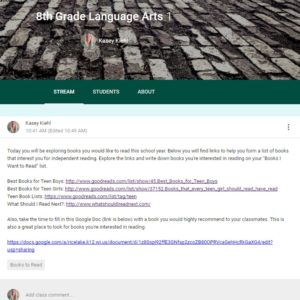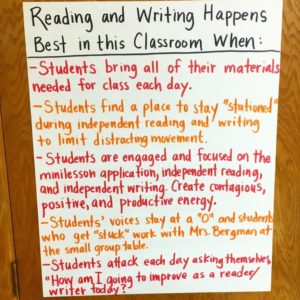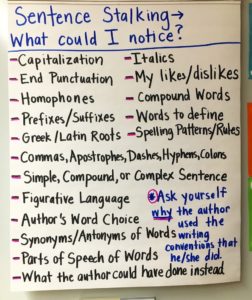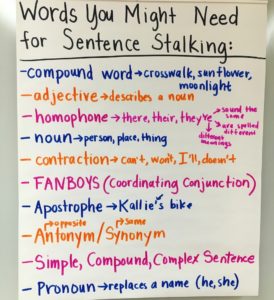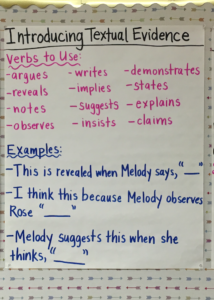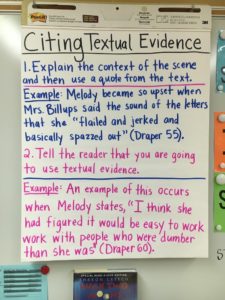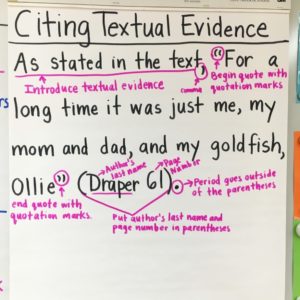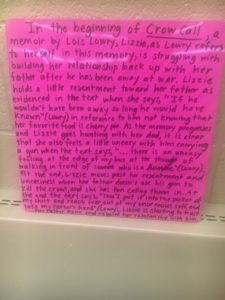When it comes to teaching reading and writing to middle school students, it’s overwhelming to know where to start with what to teach them. Below I’m going to recap a few of my favorite lessons to teach within the first two months of the school year.
Lesson One: Selecting Independent Reading Material
The way I run Reading Workshop rests on doing a daily reading minilesson following the gradual release of responsibility (modeling, have-a-go, application, share). During that application time, students are expected to apply the concept from the minilesson for the day to their independent reading book. If students are “fake reading” and have no idea what’s going on in their book or flat out don’t have an independent reading book, how are they supposed to complete the minilesson?
One common mistake we make at the beginning of the school year is that we jump right into content without laying down a foundation for reading. In order to create a reading culture in your classroom, here are a few things to try:
1. Have a minilesson focused solely on selecting engaging independent reading material. This year, I did the minilesson application on Google Classroom. Students explored sites like “Good Reads” and “What Should I Read Next” and wrote down book titles that interested them. We also started a collaborative class Google Doc where each student added a book recommendation. In the past, I have let students just go down to the library to pull any random book off the shelf as their next IR book and hope for the best. Why am I not surprised when that same student comes up to me three days later and says they’re going to abandon their current independent reading book….again. Now, before I will even sign a pass to the library, students have to show me their “Book I Want to Read” list in their Reader’s Notebook with the book they intend to checkout. If students don’t have a specific book in mind, I ask them to go to Google Classroom and spend a little time on the websites previously mentioned looking for a specific idea.
Lesson Two: Establish What Independent Reading and Writing Looks Like
In order for students to become better readers and writers, they must have time to read and write. If you don’t give them that time during class, the world of sports, friends, and technology is going to take over after school. The reading and writing more than likely is not going to happen as consistently as we would want it to. Independent reading and writing can’t happen in your class is clear expectations aren’t set collaboratively, practiced, reflected on, and reinforced daily. Trust me, it is a battle you want to fight and win because not only do students need this time to become better readers and writers, I need this time with them to be holding reading and writing conferences and guided reading and guided writing small groups. Some of my students will learn when I am teaching a whole class minilesson, but where I am truly going to make a difference is during small group and individualized instruction. If this instruction can never happen because I have to play reading and writing police, then this is a tragic loss of prime instructional time for my students. Taking the time to make sure independent reading and writing expectations are crystal clear is never a waste of time.
Lesson Three: Teach Students How to Be Sentence Stalkers
The foundation of how I run Word Study in my classroom, which encompasses grammar, writing conventions, vocabulary, spelling, etc. is through the sentence stalking of sentences from our current interactive read aloud. I don’t waste a day of school before I have students learn how to be sentence stalkers. Word Study is on the board when students walk into class, so it’s the first thing they do every single day. Teaching students how to look at the writer’s craft of what goes into writing a sentence can impact students in how they read and how they write.
Lesson Four: Citing Textual Evidence and Quality Reading Response
The first type of writing I have my students do is in response to their reading. We call this type of writing “Writing about Reading.” These responses at the beginning of the year tend to be filled with vague ideas not supported with what’s actually going on in the book. This year, my team of 8th grade LA teachers and I bit the bullet and taught how to add in and cite textual evidence extremely early on in the school year. We specifically focused on how to introduce textual evidence, how to cite it correctly, and how to explain the ideas. I don’t regret it one bit, not even a little. Teaching this writing skill right away saved me from seemingly endless hours of reading Writing about Reading responses with vague references to reading. Now that we’re writing a research paper in Writing Workshop, it’s also pretty awesome that students are connecting adding in textual evidence to adding in specific research.
The above picture is a shared writing that I did with my reading intervention group in response to the book, Crow Call, by Lois Lowry. Getting the opportunity to work with six students consistently in a small group on specific skills they need as readers and writers is a true gift!




